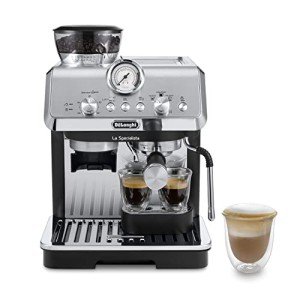10 Unquestionable Reasons People Hate Commercial Espresso Machines
The Rise of Home Espresso Machines: A Comprehensive Guide
As coffee fans continue to seek fresh and flavorful brews in your home, the popularity of home espresso machines has actually risen recently. High-Quality Espresso Machines of coffee shops and coffee bar, these machines empower people to craft barista-quality espresso beverages from the convenience of their cooking areas. This short article will explore the numerous types of home espresso machines, their features, and factors to consider for choosing the right one. Furthermore, it will offer a choice of FAQs to help prospective purchasers make notified choices.
Types of Home Espresso Machines
Home espresso machines can be categorized into numerous classifications based on their mechanisms and user-friendliness. Each type has its unique functions, pros, and cons.
Type
Description
Pros
Cons
Manual Espresso Machines
Requires the user to manually control the brewing process, involving techniques like pulling a lever to create pressure.
- Complete control over developing procedure
- Compact design
- Requires skill and practice
- Time-consuming
Semi-Automatic Machines
Machine automates water circulation and pressure, but the user still controls the dosing and duration of the brewing process.
- Balance of automation and control
- Versatile
- Learning curve for refining techniques
Completely Automatic Machines
Automates the whole brewing procedure, from grinding to brewing, often with programmable settings for customized drinks.
- Extremely user-friendly
- Quick and hassle-free
- Less control over the developing procedure
- Higher rate point
Capsule or Pod Machines
Uses pre-packaged espresso capsules or pods to produce coffee quickly and quickly.
- Extremely easy to use
- Minimal clean-up
- Limited flavor range
- More pricey per cup than ground coffee
Super-Automatic Machines
Integrates features of completely automatic machines with built-in mills, enabling users to brew entire bean espresso and milk-based drinks with one touch.
- All-in-one benefit
- Ideal for milk-based drinks
- Often the most pricey
- Can be large
Features to Consider
When selecting a home espresso machine, prospective buyers need to think about the following functions to ensure they pick a machine that meets their needs:
Grinder Type:
- Built-in mills can offer fresher grounds however may require more upkeep.
- Different mills enable more personalization of grind size.
Pressure:
- Look for machines that produce at least nine bars of pressure, which is optimal for brewing espresso.
Water Temperature Control:
- Machines with adjustable temperature settings allow for much better extraction of taste from beans.
Milk Frothing Options:
- Consider whether you desire a manual steam wand for frothing or an automatic milk frother for convenience.
Relieve of Cleaning:
- Machines with detachable parts and self-cleaning functions substantially reduce clean-up time.
Size and Design:
- Ensure the machine fits easily in your kitchen and lines up with your aesthetic choices.
Budget:
- Set a budget before beginning your search, as prices can vary substantially from affordable designs to high-end machines.
Benefits of Home Espresso Machines
Owning a home espresso machine provides various benefits:
- Cost-Effective: Over time, developing espresso in the house can conserve coffee enthusiasts money compared to frequent coffee shop visits.
- Customization: Users can explore different beans, grind sizes, and brewing techniques to discover their best cup.
- Convenience: The ability to brew espresso at any time removes the requirement to head out to a café, especially advantageous during late nights or mornings.
- Quality assurance: With a home machine, individuals have total control over the quality of components and developing procedures.
Drawbacks of Home Espresso Machines
However, there are some drawbacks to consider:
- Initial Investment: High-quality espresso machines can be costly, needing a substantial upfront investment.
- Knowing Curve: Mastering the art of espresso developing can take time and practice, which might be intimidating for novices.
- Upkeep: Like any appliance, espresso machines require regular cleansing and upkeep to ensure ideal efficiency.
FAQs
1. What is the very best type of home espresso machine for newbies?
Response: For beginners, a semi-automatic machine is often suggested as it offers a balance in between control and automation, allowing you to find out the basics without overwhelming complexity.
2. How much should I invest in a home espresso machine?
Response: Entry-level machines can start around ₤ 100 to ₤ 300, while higher-end designs can range from ₤ 500 to over ₤ 2000. It's necessary to set a budget based upon your anticipated use and wanted functions.
3. Do I require a different grinder?
Response: While some espresso machines include integrated grinders, investing in a different grinder allows for higher personalization and ensures better quality grounds.
4. How often should I clean my espresso machine?
Answer: Cleaning frequency can differ by machine type, however it's usually suggested to clean the machine after each use and carry out deep cleansings weekly or monthly, depending upon use.
5. Can I make milk-based beverages with any espresso machine?
Answer: Not all machines include milk frothing abilities. If you take pleasure in drinks like lattes or coffees, search for a machine with a steam wand or automatic frother.
Home espresso machines are changing the method coffee connoisseurs enjoy their precious brews. With Discounted Espresso Machines and advanced features available in the market, there is something for everybody. Whether it's the pleasure of creating unique dishes or simply savoring the perfect shot of espresso, investing in a home espresso machine can improve both the coffee-drinking experience and the quality of life for coffee fans everywhere. As with any investment, it is important to weigh the advantages against the potential disadvantages and select a machine that seamlessly fits both your way of life and choices.
